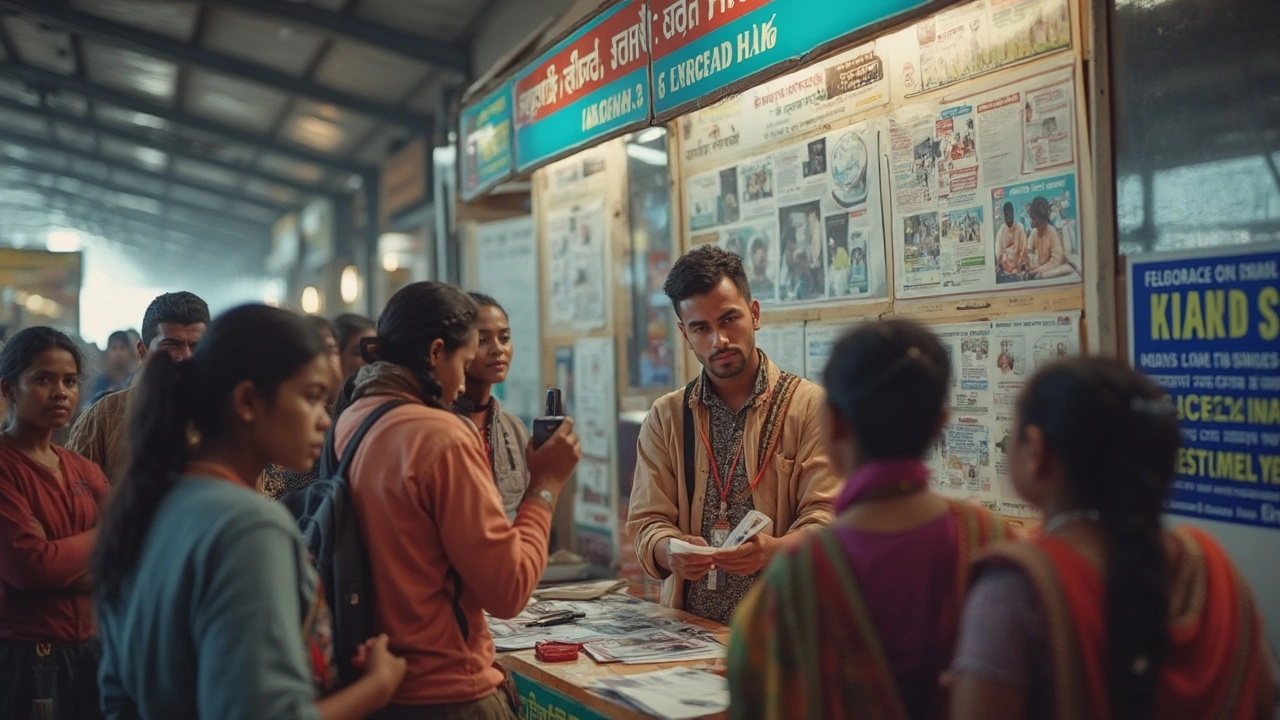
If you’re picturing dusty workbenches and dull classrooms, toss that out the window. Vocational training is all about giving you real skills for real jobs, fast. This isn’t some boring backup plan. It’s hands-on learning, almost always linked to what employers actually want—think electricians, chefs, mechanics, health workers, or even computer pros these days.
You don’t need a four-year degree to start making good money. Many folks in government vocational courses finish in a year or less, and some jump straight into entry-level jobs with a paycheck that surprises a lot of people. Here’s a wild fact: India’s Ministry of Skill Development and Entrepreneurship reports that over 5 million people were trained last year under government vocational programs—and many landed jobs before their final exams!
If you’ve ever felt stuck in “theory land” at school, vocational training could be what you need. It’s practical, direct, and often free or super affordable with government support. You learn, you practice, you get certified, and doors open—sometimes faster than you might think. Ever wondered how this works or if it’s worth it? Let’s break it down step by step.
- The True Definition of Vocational Training
- How Government Vocational Training Works
- Who Benefits from These Programs
- Surprising Facts and Success Stories
- Tips for Making the Most of Vocational Training
The True Definition of Vocational Training
So, what exactly is vocational training? If you think of regular school as a deep dive into textbooks, vocational training flips that on its head. It’s about learning specific skills you can use right away at work. You don’t sit through years of theory hoping it’ll pay off someday. Instead, you get hands-on practice and real-world know-how—tailored for jobs that need workers, pronto.
Vocational training isn’t new. Way back in the early 20th century, India set up Industrial Training Institutes (ITIs) to meet the country’s growing need for skilled workers. Today, there are over 15,000 ITIs and nearly 8,000 private vocational training providers all over the country, teaching everything from welding to digital marketing.
“Vocational education is about connecting learning with the labour market. It’s not just about jobs—it’s about building a skilled workforce for a modern economy,” says Anant Kumar, director at the National Skill Development Corporation.
This approach covers fields like electrical work, carpentry, healthcare, hospitality, and more. Courses are usually short, flexible, and full of internships or apprenticeships. Let’s clear things up with a quick breakdown:
- Learning by doing—lots of practice, little theory
- Courses directly linked to jobs in demand
- Certificates, diplomas, or licenses you can actually show to employers
- Entry possible after 10th or 12th standard, or even later in life
- Offered by government, private institutes, or even online
Here’s a snapshot from 2023 showing the reach and demand for vocational training in India:
| Program | Number of Enrollees | Top Sectors |
|---|---|---|
| ITI (Industrial Training Institutes) | 2.1 million | Electrician, Fitter, Mechanic |
| Short-term government skill courses | 3.5 million | Healthcare, Hospitality, Retail |
| Online skill certifications | 700,000 | Digital Marketing, Data Entry, Coding |
If you want a clear path to a specific job, not a never-ending slog through textbooks, vocational training makes total sense. It’s practical, focused, and keeps changing to match what companies really need right now.
How Government Vocational Training Works
Here’s how these programs actually tick. The government sets up vocational training through a mix of public and private institutes—think ITIs, polytechnics, skills centers, and sometimes even big companies partnering with the government. Courses can last anywhere from a couple of months to two years, depending on what you sign up for. The main focus: learn by doing, not by cramming theory. You could be wiring a real circuit, fixing an engine, baking breads, or coding apps—whatever the job demands.
Most government-run courses are either free or heavily subsidized. If you can’t afford it, many states offer scholarships or stipends, especially for students from low-income families, women, and people with disabilities. The point is to include everyone who wants practical job skills. At the end, you walk out with a government-recognized certificate. This certificate isn’t just a piece of paper—it signals to employers that you’re job-ready.
Take a look at how some of the biggest government vocational training schemes stack up:
| Scheme | Launched | Who Can Join | Main Focus |
|---|---|---|---|
| Pradhan Mantri Kaushal Vikas Yojana (PMKVY) | 2015 | All citizens, 15-45 years | Short-term skill training |
| ITI (Industrial Training Institutes) | 1950s | After Class 10/12 | Trade-specific hands-on skills |
| National Apprenticeship Promotion Scheme (NAPS) | 2016 | Youth, freshers, workers | On-the-job apprenticeship |
The vocational training process usually goes like this:
- Choose your course—electrician, plumbing, data entry, even mobile repair or hospitality.
- Apply online or at a center, submit basic documents like ID and education proof.
- Attend classes and loads of practical lab sessions. Many courses have more practice time than desk work.
- Pass regular tests, sometimes including real projects or live assessments from industry partners.
- Get your government certificate. In some programs, placement teams help you get interviews with companies right away.
A quick tip: Always check if the institute is government approved. The Ministry of Skill Development runs a website where you can find verified centers and up-to-date info on batches and results. If someone in your family is considering this path, push them to pick an institute on that list—it’s safer, and companies take these certificates more seriously.

Who Benefits from These Programs
When it comes to vocational training, the idea that only school dropouts or people with no options sign up simply isn’t true anymore. These days, people from all walks of life are getting involved. Whether you’ve just finished school, want a career switch, or need to upskill to earn more, vocational programs are designed with real-world needs in mind.
Here’s who typically benefits the most:
- School leavers: Kids who don’t want a university degree, or simply can’t afford it, can pick up a trade and get working quickly.
- Unemployed adults: These programs can help people who have lost jobs or never had solid employment find a new way in.
- Working professionals: People already on the job can reskill or upskill to move up in their field or switch careers altogether.
- Women returning to work: Many women—like my wife, Nalini, after our kids got older—find that vocational courses give them the flexible, targeted learning they need to jump back into the workforce.
- People in rural areas: Government efforts in India have focused on communities far from city centers, offering training right where jobs are needed.
Government stats from January 2024 show who’s actually taking part in these programs and how they’re faring:
| Group | Percentage of Trainees | Placement Rate After Training |
|---|---|---|
| School Leavers (16-22 yrs) | 42% | 62% |
| Women (all ages) | 28% | 56% |
| Rural Residents | 33% | 58% |
| Mid-career Professionals | 15% | 67% |
So, is it just the traditionally “unskilled” who join? Not even close. Vocational training is for anyone who wants a faster track to real jobs. These programs have become lifelines for school leavers, support for working parents, and even a jumpstart for those looking to pivot into a new, better-paying field.
Surprising Facts and Success Stories
People usually think of vocational training as a last resort, but some numbers totally flip that idea. Did you know the National Skill Development Corporation (NSDC) says over 70% of trainees in government-run programs score jobs within six months of finishing? That’s way faster than most university graduates manage these days. And get this—more than half of those jobs are in small or medium-sized companies, not just big factories or workshops.
There’s a popular belief that only youngsters join these programs, but last year, the Ministry of Skill Development reported that nearly 20% of trainees were over 35. Plenty were folks like my neighbor Suresh, who switched from a struggling shop job to plumbing, trained for six months, and now earns twice what he did before—plus, he sets his own hours.
It’s not just about trades like carpentry or mechanics anymore. Lately, government schemes focus on sectors like healthcare tech, beauty services, and computer operations. In 2024, the Skill India Mission started a women-only coding bootcamp. By December, nearly 60% of those women landed jobs, including some who never used a computer before joining. That’s real progress for people who thought a tech career was out of reach.
What’s wild is the ripple effect. When people land steady work after training, local businesses notice. My cousin’s bakery hired two certified bakers from a government hospitality program, and within six months, business was so good they opened a second shop. Turns out, investing in trained people pays off for everyone—trainees, families, and communities.
If you’re skeptical about whether vocational training is worth your time, just look around. These success stories aren’t one-offs; they’re happening every day because the system matches actual job needs. Real skills, real jobs, and real paychecks—no fluff. That’s what makes these programs stand out from the crowd.

Tips for Making the Most of Vocational Training
Getting into a vocational training program isn’t just about showing up. If you want to really cash in on the perks, you have to get your hands dirty and stay sharp. I’ve seen folks breeze through courses and leave with little to show for it, but the ones who go the extra mile? They land the good jobs, sometimes even before graduation. Here’s how you can do the same.
- Be proactive: Don’t wait for trainers to spoon-feed everything. Ask questions, join extra workshops if available, and find out what skills are in demand by talking to industry folks who sometimes visit as guest speakers.
- Network like crazy: Your classmates, instructors, and visiting professionals can help you later. Nalini, my spouse, still gets job tips from her old vocational course WhatsApp group!
- Practice outside of class: Use online tutorials, free apps, or community projects to sharpen your skills. You’ll be amazed at how much this boosts your confidence during job interviews.
- Keep an eye on internships: Many government vocational training programs now include real-world placements—grab those opportunities even if they’re unpaid at first. According to the National Skill Development Corporation, nearly 42% of trainees who did internships landed better jobs or pay hikes in 2024.
- Don’t slack on the certification: In a survey by the Ministry of Skill Development and Entrepreneurship, 9 out of 10 employers said they check for proper vocational certs before hiring.
Want the best shot at a good job? Boost your foundation with English or digital skills—both are big ticket items in most industries these days.
“Vocational training is the bridge between knowing and doing. The more you practice, the better your career prospects,” says Rajesh Kumar, Director at Delhi Skill and Entrepreneurship University.
Quick look at some stats from last year on success rates:
| Course Type | Placement Rate (%) | Average Starting Salary (per month) |
|---|---|---|
| Electrician | 68 | ₹18,000 |
| Healthcare Assistant | 74 | ₹16,500 |
| Automobile Technician | 60 | ₹17,200 |
| IT/Computer Support | 80 | ₹22,000 |
Don’t just sign up and coast through. Make your time in vocational training count, and you’ll be the first one getting called up for jobs that actually pay well and feel rewarding.
